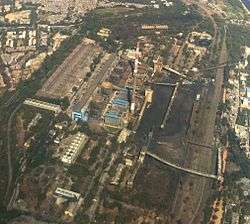Badarpur Thermal Power Station
| Badarpur Thermal Power Station | |
|---|---|
 Aerial view of Badarpur Thermal Power Station | |
| Country | India |
| Location | Mathura Road, Badarpur, Delhi. |
| Coordinates | 28°30′20″N 77°18′25″E / 28.50556°N 77.30694°ECoordinates: 28°30′20″N 77°18′25″E / 28.50556°N 77.30694°E |
| Status | Active |
| Commission date | 1973 |
| Operator(s) | NTPC |
| Thermal power station | |
| Primary fuel | Coal |
| Power generation | |
| Units operational | 5 |
| Nameplate capacity | 705 MW |
| www.ntpc.co.in | |
Badarpur Thermal Power Station is located at Badarpur area in NCT Delhi. The power plant is one of the coal based power plants of NTPC. The National Power Training Institute (NPTI) for North India Region under Ministry of Power, Government of India was established at Badarpur in 1974, within the Badarpur Thermal power plant (BTPS) complex.[1]
Power plant
The Badarpur Thermal Power Station has an installed capacity of 705 MW. It is situated in south east corner of Delhi on Mathura Road near Faridabad. It was the first central sector power plant conceived in India, in 1965. It was originally conceived to provide power to neighbouring states of Haryana, Punjab, Jammu and Kashmir, U.P., Rajasthan, and Delhi. But since year 1987 Delhi has become its sole beneficiary. It was owned and conceived by Central Electric Authority. Its construction was started in year 1968, and the First unit was commissioned on 26 July 1973. The coal for the plant is derived from the Jharia Coal Fields. This was constructed under ownership of Central Electric Authority, later it was transferred to NTPC.
It supplies power to Delhi city. It is one of the oldest plant in operation. Its 100 MW units capacity have been reduced to 95 MW. These units have an indirectly fired boiler, while 210 MW units have a directly fired boiler. All the turbines are of Russian design. Both turbine and boilers have been supplied by BHEL. The boiler of the Stage-I units are of Czech design. The boilers of units 4 and 5 are designed by Combustion Engineering (USA). The instrumentation of the stage I units and unit 4 are of Russian design. The instrumentation of unit 5 is provided by M/S Instrumentation Ltd. Kota, and is of Kent design.
In 1978 the management of the plant was transferred to NTPC, from CEA. The performance of the plant increased significantly, and steadily after the take over by NTPC until 2006, but now the plant is facing various issues.
Being an old plant, Badarpur Thermal Power Station (BTPS) has little automation. Its performance is deteriorating due to various reasons, like aging, poor quantity and quality of cooling water etc. It receive cooling water from Agra Canal, which is an irrigation canal from Yamuna river. Due to rising water pollution, the water of Yamuna is highly polluted. This polluted water when goes into condenser, adversely affect life of condenser tubes, resulting in frequent tube leakages. This dirty water from tube leakages, gets mixed into feed water cycle causes numerous problems, like frequent boiler tube leakages, and silica deposition on turbine blades.
Apart from poor quality, the quantity of water supply is also erratic due to lack of co-ordination between NTPC and UP irrigation which manages Agra Canal.
The quality of the coal supplied has degraded considerably. At worst times, there were many unit tripping owing to poor quality. The poor coal quality also put burdens on equipment, like mills and their performance also goes down.The coal for the plant is fetched from far away, that makes the total fuel cost double of coal cost at coalmine. This factor, coupled with low efficiency due to aging and old design makes electricity of the plant costlier.
Presently the management is headed by Mr. Chandan Chakraborthy, General manager.[2]
The cost of power from Badarpur is Rs 4.62/kWh[3] making it one of the most costly in India.[4]
Environmental Effects
According to a 2015 study by the Centre for Science and Environment, The Badarpur Power Plant is the most polluting power plant in India. The plant contributed only 8% of the Delhi's electric power but produced 80 to 90% of the city's particulate matter pollution from the energy sector.[5]
During the Great smog of Delhi, the power plant was shut down to alleviate the acute air pollution suffered by residents of the city. It was restarted on March 16, 2017. Environment Pollution Prevention and Control Authority (EPCA) has proposed to close down the plant by July 2018.[6]
Installed capacity
The Badarpur Thermal Power Station has an installed capacity of 705 MW.
| Stage | Unit Number | Installed Capacity (MW) | Date of Commissioning | Status |
|---|---|---|---|---|
| First | 1 | 95 | July, 1973 | Stalled |
| 2 | 95 | August, 1974 | Stalled | |
| 3 | 95 | March, 1975 | Stalled | |
| Second | 4 | 210 | December, 1978 | Running |
| 5 | 210 | December, 1981 | Running | |
References
- ↑ "Our Institutes". National Power Training Institute website.
- ↑ "Badarpur Thermal Power Station". National Thermal Power Corporation.
- ↑
- ↑
- ↑ "The Badarpur Plant's effect on air pollution and why it needs to be shut down". The Economic Times. 12 August 2016. Retrieved 25 November 2016.
- ↑ "Badarpur thermal power station to start operations on Thursday". Hindustan Times. 15 March 2017. Retrieved 10 April 2017.
